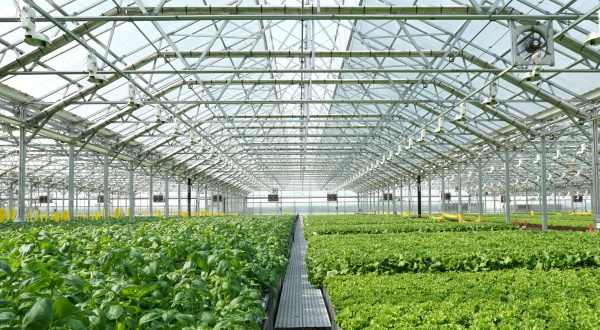
Catoctin Mountain Growers (“Catoctin”), located in Keymar, has been in the ornamental flower business for decades. Founded in 1985 by Bob and Denise Van Wingerden, the business has played a key role in supplying ornamentals to large retailers such as Walmart.
While wildly successful, a team of engineers at Gaithersburg-based JumpLights saw a unique partnership opportunity to help Catoctin be even more productive. Like many other greenhouses, Catoctin traditionally used 600-watt High Pressure Sodium (HPS) fixtures to supplement light for their plants, and the fixtures were past their prime.
JumpLights, founded in 2016 out of co-founder and chief technology officer Matteo del Ninno’s garage, develops innovative LED horticulture lighting for farmers practicing controlled environment agriculture (CEA). Together, the two businesses wanted to see if JumpLight’s products could have a positive impact on plant growth to both enable inter-season production and boost overall output during peak growing seasons. In addition, they wanted to assess the optimal LED light intensity to help Catoctin be more energy efficient.
To support the project, Catoctin and JumpLights sought help from the Maryland Technology Development Corporation (TEDCO) by applying to their Agriculture and Rural Rebuild (ARR) Challenge. As Maryland’s economic engine for technology and life science startups, TEDCO launched the ARR Challenge in early 2021 as a means of supporting rural and agricultural businesses in Maryland adversely affected by the ongoing pandemic and economic downturn.
The ARR grants, which provided funding of up to $200,000, were designed to encourage collaborations between applicants, research institutions and industries. The vision was to facilitate the development of long-lasting technological improvements in the agriculture technology (Agtech) field and other rural industries. The Catoctin and JumpLights collaboration was one of seven award recipients.
“Contract ornamental growers are under a lot of pressure – most of the growing needs to happen between January and March for the plants to be ready to put in the ground in March or April. And Maryland winters can sometimes be unpredictable,” said del Ninno.
The bulk of the project involved testing different greenhouse bays with various LED intensities and spectra, with one experimental bay having high pressure sodium bulbs as a control.
Overall, the project was a huge success. “The results were outstanding, and we were able to ultimately cut Catoctin’s lighting energy consumption by ~41%,” noted John Peeler, JumpLights CEO.
In fact, one of the biggest hurdles the companies faced was that the lights worked too well at first. As a result, Catoctin’s flowers thrived and were ready to sell earlier than retailers needed. “This isn’t really a bad thing, though, because it means that Catoctin has the opportunity to expand their business outside of Maryland to warmer climates that are ready to sell earlier,” said Peeler.
Besides allowing Catoctin to successfully grow plants during the off season and increase overall product output, JumpLights was also able to experiment with different spectrums of light to see what morphological effects they might have on the plant, focusing first on lettuce.
“Light provides two key things to plants – one is photosynthesis, which we’re all familiar with, and the other is photomorphology. Plants take signals from light to understand what they need to do,” said del Ninno. “In lettuce, we tested and found we could hit the leaves with different light spectra to make them not only more desirable for market, but also more nutritious. If we hit them with a high blue light ratio in the finishing growth stages, for example, they develop more antioxidants to be able to respond to the more intense, shorter wavelength blue light.”
Both Catoctin and JumpLights have continued to find great success. Catoctin has expanded their capabilities significantly, while JumpLights has introduced their innovative horticulture lights to different companies.
“Right now, we’re working with about six companies – our next steps are to see how our lighting could be used for fruiting plants, such as tomatoes and cucumbers,” said del Ninno. “We’ve also been open to exploring the cannabis industry to meet the recent dispensary demand following it’s legalization in Maryland.”
“TEDCO’s ARR grant helped all of us in a number of different ways,” added Peeler. “First, we had the means to really dig in and study the impact of different types of LED light on plant growth, enabling us to scale our R&D and product development. Second, Catoctin Mountain Growers is now a lot more competitive because they can now expand their offerings year-round while also being more sustainable. Not only is their business booming, but being able to grow plants year-round also means more job opportunities across the state.”
“COVID-19 had a major impact on Maryland’s rural and agriculture economies, both of which are crucial to the state’s infrastructure,” said Arti Santhanam, Ph.D., executive director of the Maryland Innovation Initiative and manager for the ARR challenge. “It’s been a little over two years since we first announced the ARR Challenge to tackle this issue. We specifically hoped to connect the latest technological innovations to agricultural industry to bring about tangible and economically scalable improvements and I’m excited that we’re starting to see the fruits of these collaborations start to take shape.”
Written by Tammi Thomas, chief development and marketing officer at TEDCO.
Source: The Daily Record